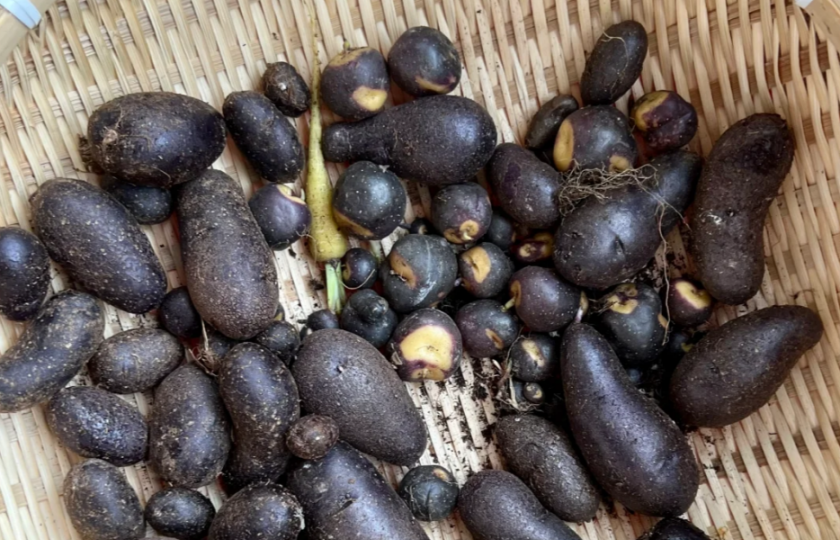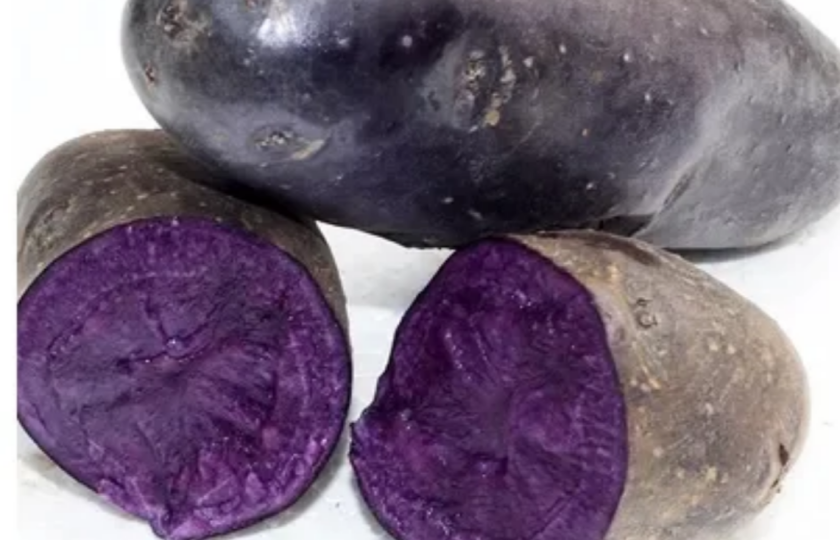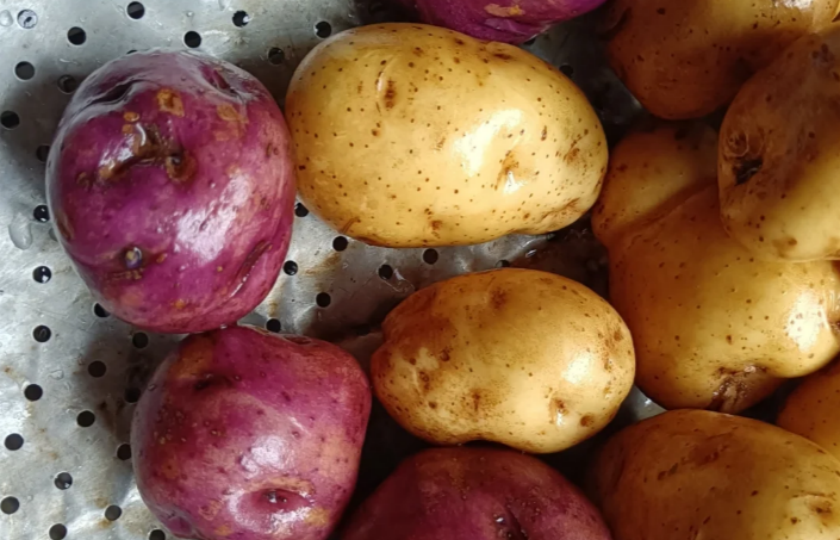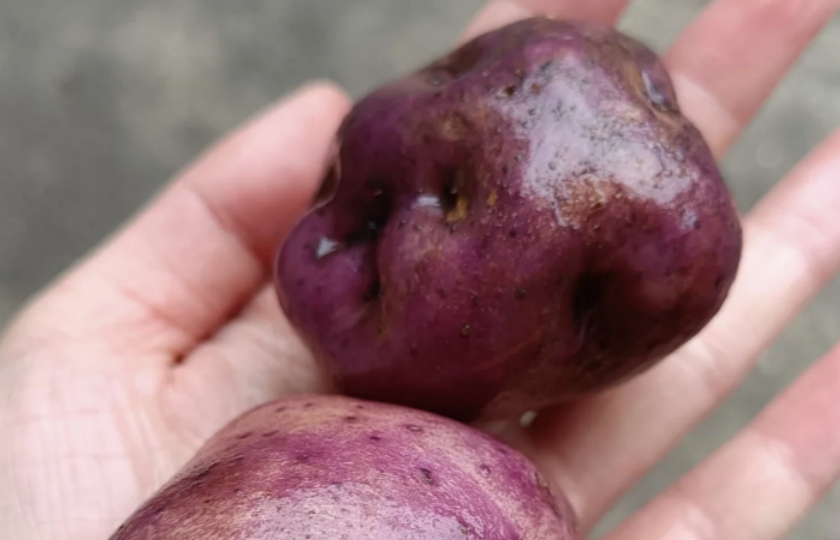I’ve never seen this before—why are my purple potatoes green?

I bought some purple potatoes and was going to cook and eat them when I got home. But when I got back, I found that they were green. What on earth is going on? So, I started an exploration of purple potatoes, and the answer gradually emerged.
Why are my purple potatoes green?
The greening of purple potatoes may be caused by the following factors:
First of all, it should be known that the reason why purple potatoes are purple is because they contain a natural pigment called "anthocyanin". However, when purple potatoes are exposed to sunlight or improperly stored, the anthocyanin in the purple part may change, and even chemical reactions may occur during the heating process, and the color of the potatoes turns green.
Light: If purple potatoes are exposed to sunlight during growth or storage, it will promote the synthesis of chlorophyll and cause the epidermis to turn green.
Storage conditions: Unsuitable storage temperature and humidity may also accelerate the chemical changes inside the potato and lead to color changes.
Variety characteristics: Different varieties of potatoes react differently to light and storage conditions. Some varieties are more likely to turn green.
If your purple potatoes turn green, remember to check whether they have been exposed to direct sunlight during storage. It is best to store them in a cool place.
Can green potatoes be eaten?
Whether green potatoes can be eaten depends on the actual situation.
If the potato is only slightly green, for example, only the edge or part of it is slightly green, then you can cut off the green part and the remaining part can still be eaten. When potatoes turn green, chlorophyll is produced, and at the same time, a small amount of solanine may also be generated. Cutting off the green part can remove most of the places that may contain high concentrations of solanine.
But if most of the potato turns green or the green part is very deep, it is not recommended to eat it. Because this means that the content of solanine may be relatively high. Solanine is a toxic alkaloid. After eating it, we may experience poisoning symptoms such as nausea, vomiting, abdominal pain, and diarrhea.
How to tell if purple potatoes have gone bad?
Look at the color
The most direct way to judge whether purple potatoes have deteriorated is to observe their color. Usually, deteriorated purple potatoes will have blue or light blue spots, or green spots on the surface and inside.

Check for germination
Germinated purple potatoes will produce solanine, which is a toxic substance. If there are obvious eyes or sprouts on the surface of the potato, it is recommended not to eat it.
Check the inside
You can also cut open the purple potato and observe whether there is discoloration, mildew or peculiar smell inside. If there are gray, blue or black patches inside, it may be a sign of deterioration.
Smell
Deteriorated purple potatoes usually emit a rancid smell and may have a bitter taste or other peculiar smells. If you smell an abnormal smell, it is recommended not to eat it.
Touch inspection
Deteriorated purple potatoes may become softer, with liquid seeping out, or become drier and harder. These changes indicate that the purple potatoes have begun to rot or be infected by fungi.
What types of food poisoning can green potatoes containing solanine cause?
Green potatoes containing solanine can indeed cause food poisoning. Solanine is a natural toxin that is mainly found in the germination site, around the bud eye, and in the green part of the potato. Although under normal conditions, solanine has little effect on our body, if it is consumed in excess, it may cause the following types of food poisoning reactions:

Gastrointestinal discomfort: Solanine can irritate the digestive system, causing symptoms such as nausea, vomiting, diarrhea, and stomach pain. These symptoms are especially pronounced when consumed in excess. Since solanine is highly irritating to the gastrointestinal tract, it may cause abdominal discomfort and even severe diarrhea.
Nervous system reactions: Solanine also has a certain toxic effect on the nervous system. High concentrations of solanine may cause symptoms such as headache, dizziness, drowsiness, and fatigue. In severe cases, abnormal manifestations of the nervous system may occur, affecting the coordination of the body, and may even cause breathing difficulties or irregular heartbeats.
Poisoning symptoms: If the amount of solanine consumed is extremely large, it may cause poisoning symptoms. Severe solanine poisoning can be life-threatening, but it is relatively rare and usually requires eating large amounts of green potatoes, especially the green and sprouting parts. However, solanine is not present in all green potatoes at dangerous levels. In most cases, solanine levels only increase significantly when the potatoes are exposed to light for a long time and sprout.
Will solanine be destroyed by cooking?
Ordinary cooking methods, such as boiling, steaming or stir-frying, are difficult to completely destroy solanine. However, high-temperature cooking can reduce the content of solanine to a certain extent. For example, frying can decompose part of the solanine in potatoes, but it cannot be completely eliminated.
Even after cooking, potatoes with high concentrations of solanine, such as those that are already green or have sprouted severely, may still cause poisoning. So, if there is a lot of green part or the sprouts are very severe on the potato, even if it is cooked, it is not recommended to eat it again.
For safety reasons, the best way is to avoid using potatoes that may have excessive solanine content and try to choose fresh potatoes without sprouts and greening to cook delicious dishes.
Can potatoes still be eaten after sprouts are removed?
It is not recommended to eat potatoes after sprouts are removed.
After potatoes sprout, a toxic substance called solanine will be produced. And this substance is not only present in the sprout eyes. Although removing the sprout eyes can reduce the toxin, it cannot be completely eliminated.

Especially for potatoes with a high degree of sprouting, eating them may cause poisoning and symptoms such as nausea, vomiting, abdominal pain, and diarrhea. Therefore, in life, it is not recommended to risk your own health.























